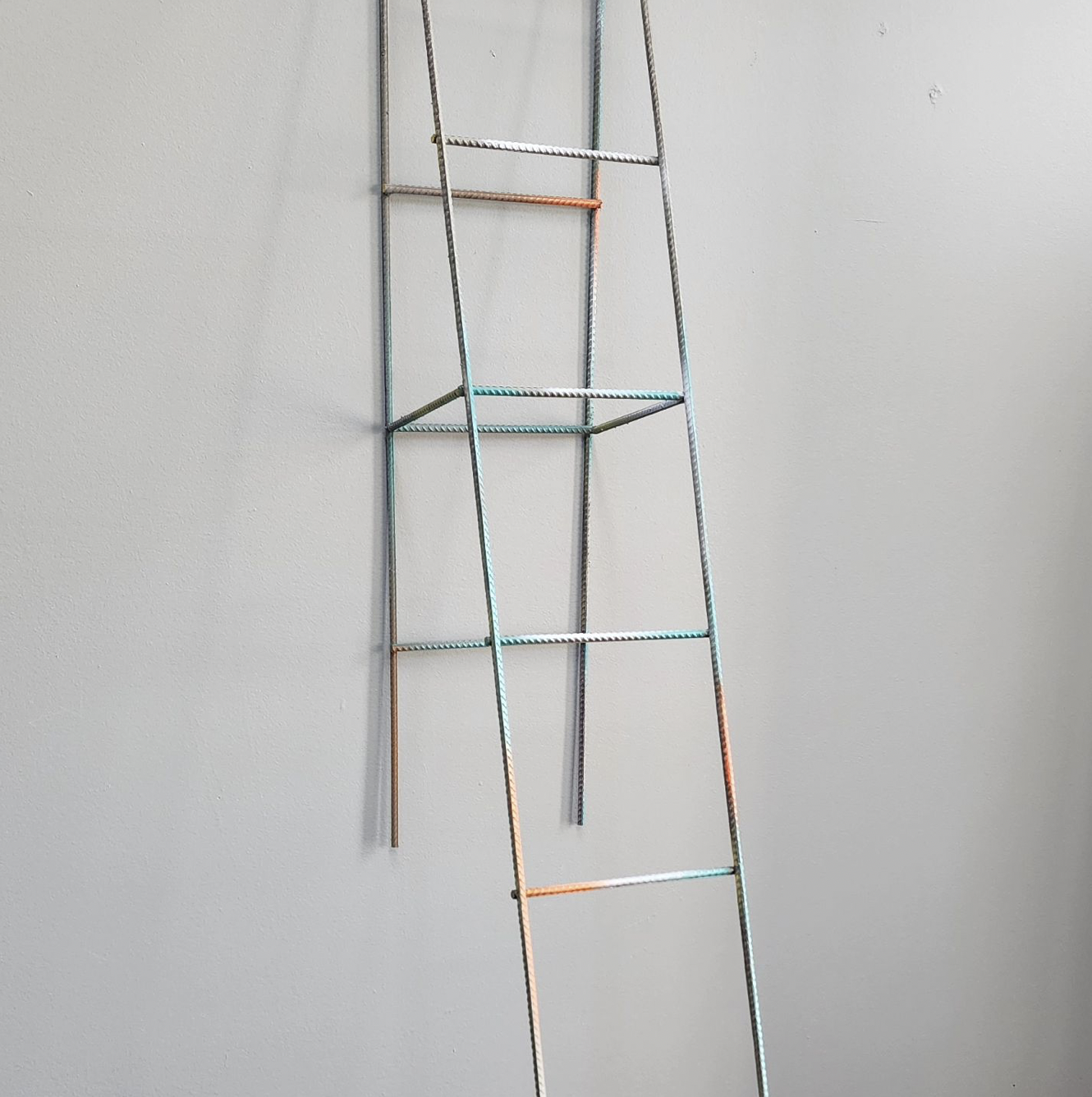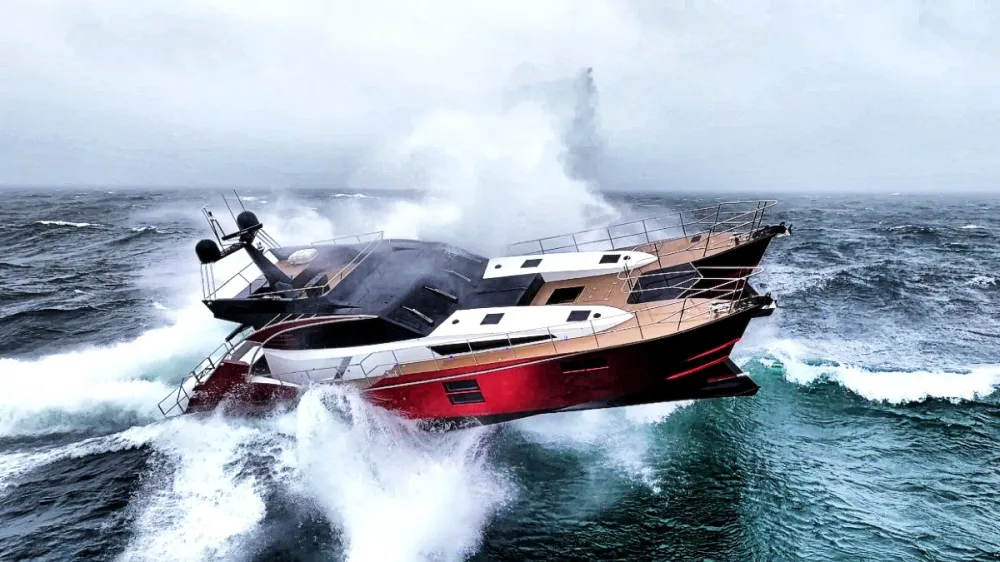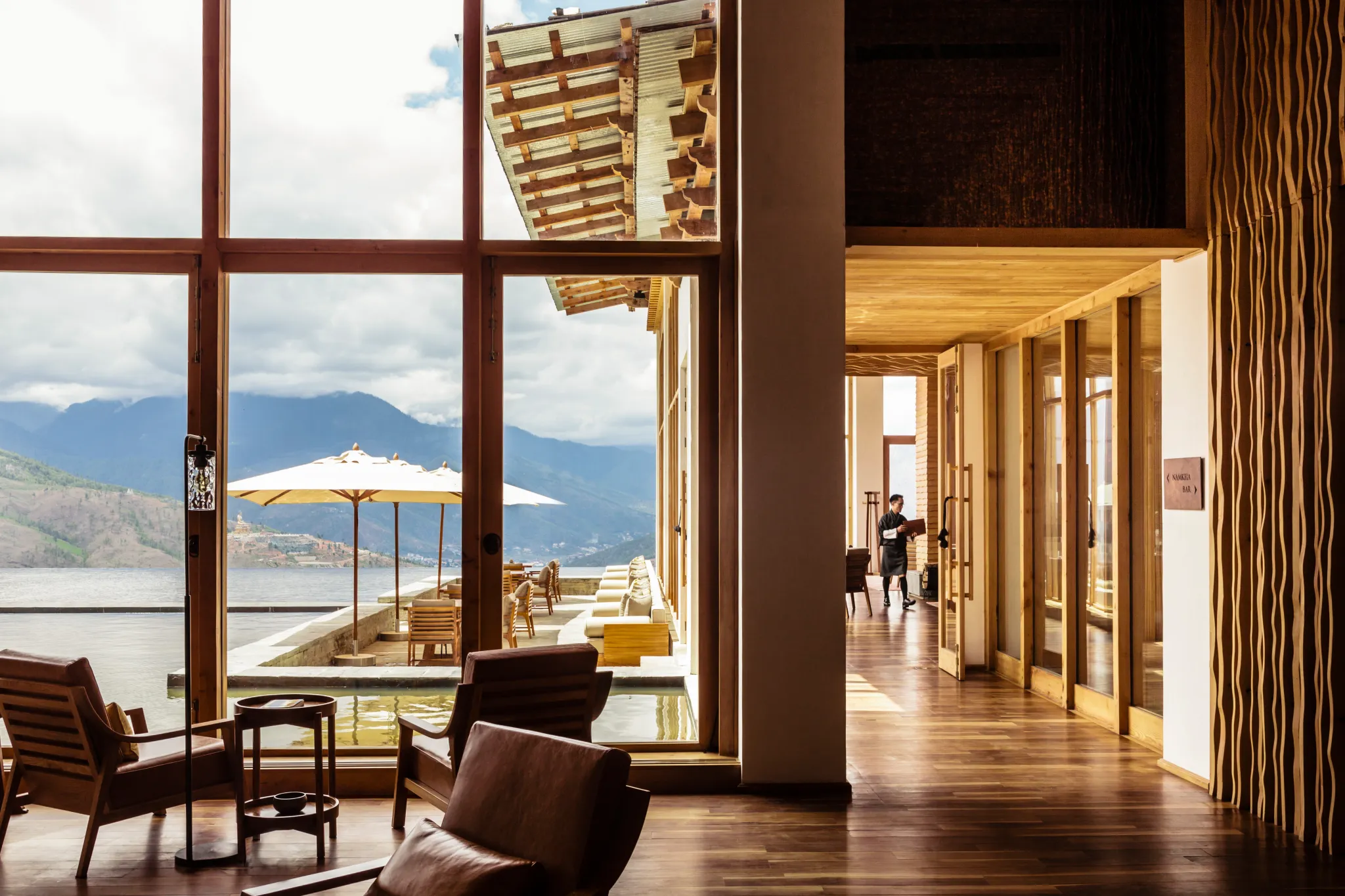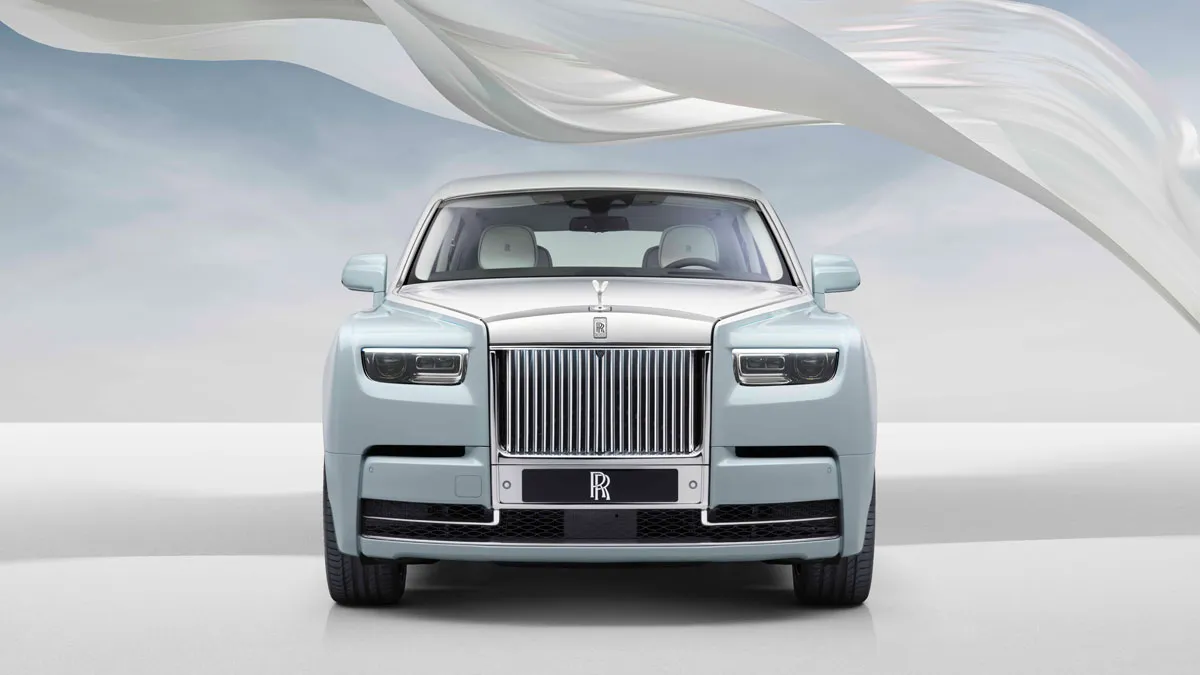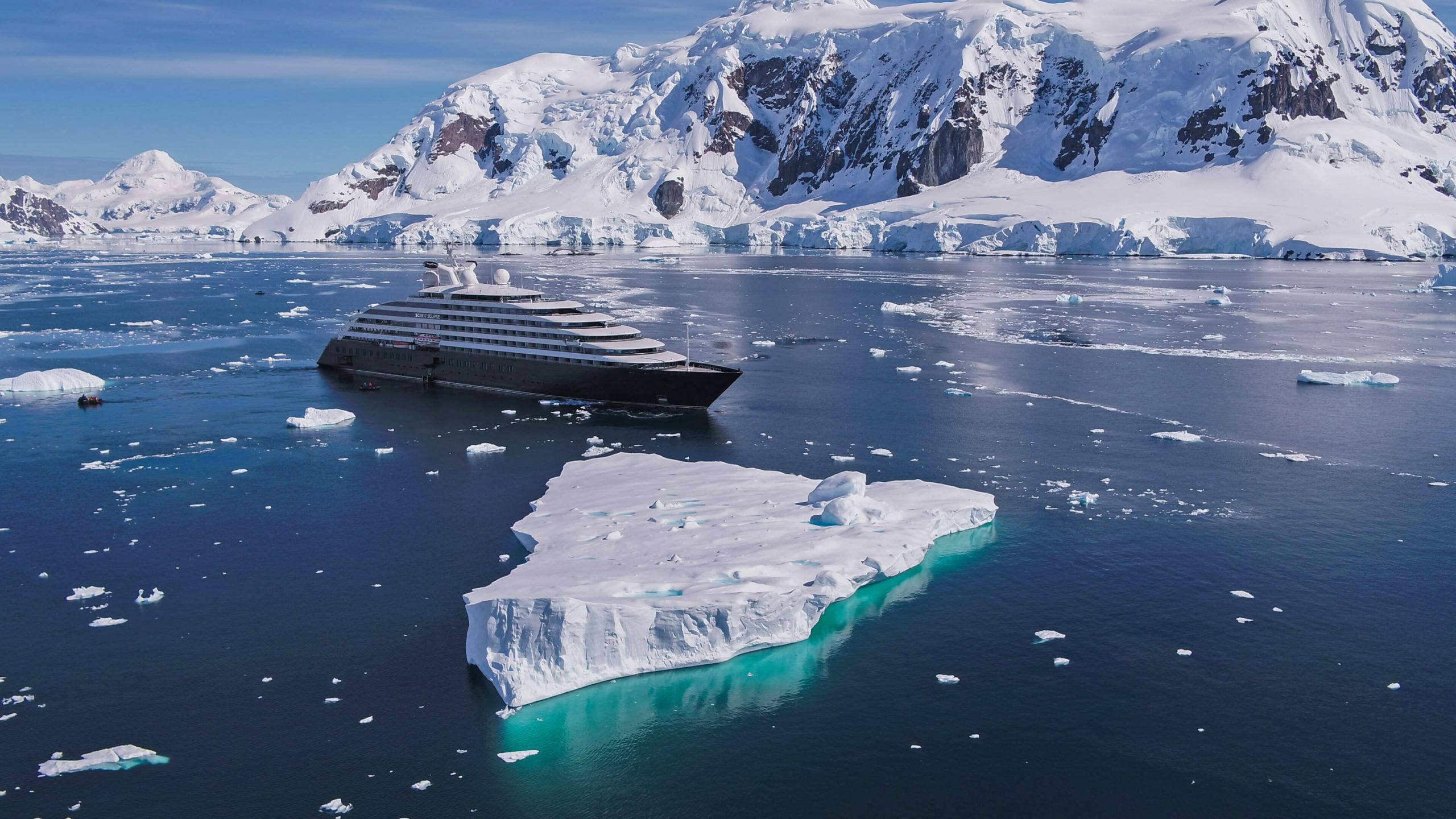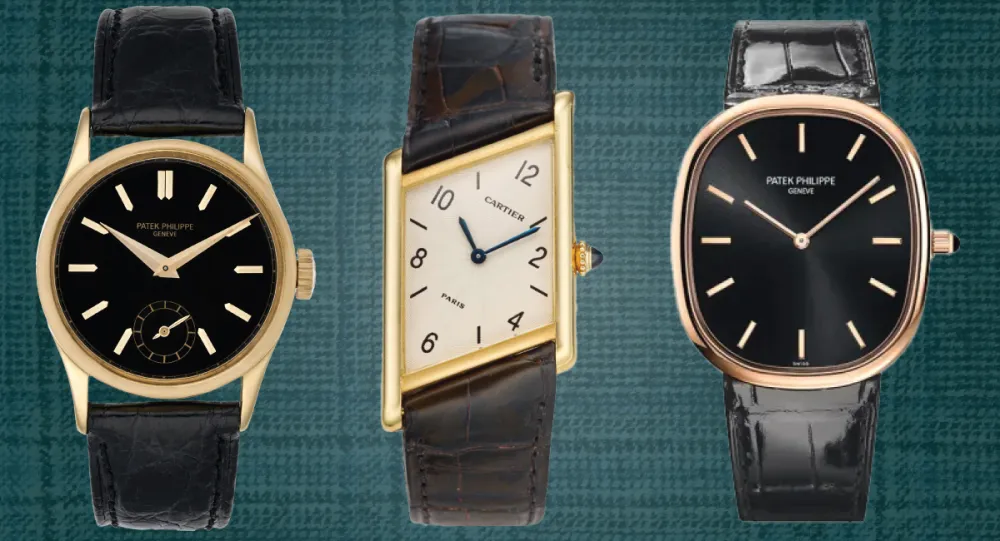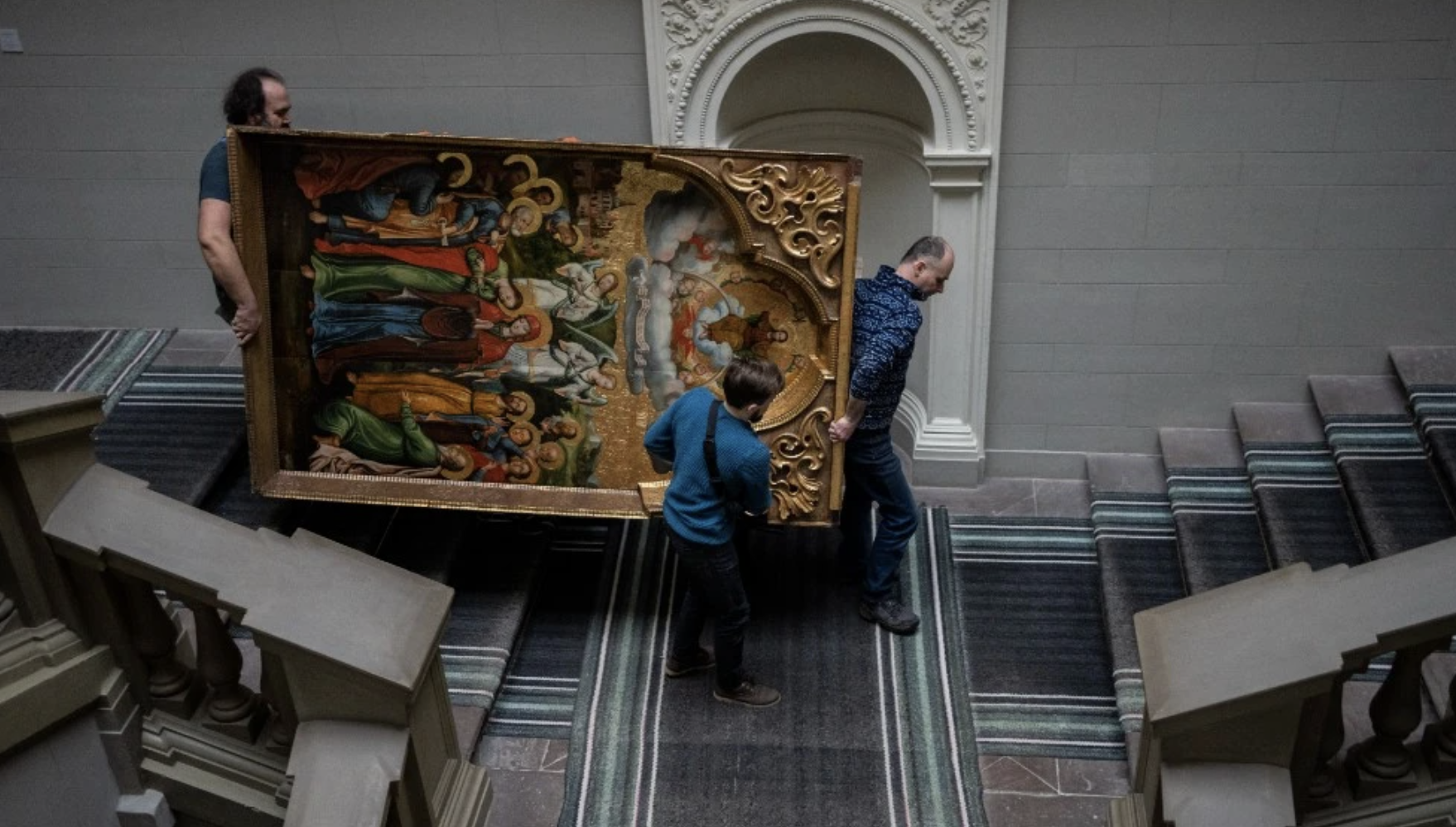
‘Don’t Film Any Soldiers, They May Shoot Us’: Inside Ukraine’s Secret Battle To Save Its Art
Art critic Waldemar Januszczak reports on the country’s astonishing mission to stop the destruction of its artistic treasures.
Related articles
I have no concrete idea how I ended up in Ukraine last week finding out about the national art and seeing how it was being saved from Russian bombs. All gods move in mysterious ways, but the gods of art are especially fickle.
It started a fortnight ago with a meeting in London of 10 of Poland’s most important museum directors. They had come over to discover why British culture appeared to be so uninterested in Polish culture. They told me their story, and I was asked about mine. So I told them.
How my mother was born in Ukraine in what were then Polish lands. How in 1939 the Russians invaded and put her on a cattle truck to Siberia. She was 16. How, when the Russians turned against the Nazis two years later, they opened up the labour camps and she walked from Siberia to the Middle East with hundreds of thousands of other newly freed Poles. How she fetched up in England. And had me. How art was my way of seeing light at the end of the tunnel.
When she was 60, I fixed it for my mother to swap her tatty “stranger’s papers” for a proper British passport, and took her back to the Ukrainian village of Lipica Dolna where she was born, some 60 miles from Lviv. The house was still there: big in her thoughts, tiny in reality. We went to Lviv, too, visited the cathedral, visited the museums. And we sobbed our eyes out together under the statue of Adam Mickiewicz, Poland’s national poet. So for me, Ukraine was personal.
Spilling all this to the Polish museum directors was causing me to tear up pathetically, so, in an effort to distract myself from me, I asked if they knew what was happening to Ukraine’s art and to Lviv’s museums? Were they safe?
They’re being looked after, piped up the director of the National Museum in Poznan, Tomasz Lecki. A couple of weeks earlier he had driven a five-ton truck to Ukraine filled with the most precious material a museum needs in times of war bubble wrap. The Ukrainians were hiding their art. They’d run out of packing materials. The Polish museums were resupplying them.
You can go and see for yourself, he added. I suppose I can, I whispered back, wishing I was as evidently Polish and brave as he was. That must be when the gods of art got involved. Because the next thing I know, Tomasz and Marta de Zuniga, the unstoppable life force from the Polish Cultural Institute who organized the event, are jointly planning my journey.
Lviv is 45 miles from the Polish border. Driving there in the dark we pass regular checkpoints, chicanes made of sandbags, flanked by homemade tank traps that look like giant metal sea urchins. The people from the Polish consulate in Lviv, who had met us at the border and got us through, tell us not to film any Ukrainian soldiers. They might shoot us.
On the drive to Lviv, giant billboards keep looming up in the dark emblazoned with stirring Slavic calls to arms. “Be ready to join the army and save Ukraine,” says a prosaic one. “Our enemies fade away, like dew in the sunshine,” says a poetic one. “Russian war ships, f* you!” says one with a clear Slavic ambition to get to the point. Every few miles, these rousing national addresses pop up out of nowhere, like stage whispers from the gods.
Lviv is exactly as I remembered it. Such a beautiful city. Cobbled and gothic, the streets untouched by yellow lines, the architecture with a fairytale mood to it that you just don’t get west of Berlin. We visit the Lviv National Art Gallery, the largest museum in Ukraine. Rumor has it that all the nation’s important art treasures have been sent to Lviv for safekeeping. So where are they?
Throughout its entire history Ukraine has been a motorway for anyone heading west or east in Europe. Whether you’re Napoleon marching on Moscow or the Golden Horde riding to Berlin, you pass through Ukraine. And all these cultures—Scythians, Tatars, Germans, Russians, Poles, French—have left their mark on the local art. The result is a wild mix of styles and influences that make Ukrainian art spectacularly varied. Now it is all under threat.

Workers move the Annunciation to the Blessed Virgin of the Bohorodchany Iconostasis in the Andrey Sheptytsky National Museum as part of safety preparations in the event of an attack in the western Ukrainian city of Lviv. Associated Press
The museum in Lviv is next door to a refugee relief center where busy volunteers hand out packages to the lucky few waving the correct ticket at them. You register online. Get a QR code in return. Wait your turn. Then pick up your package from counters scattered about the city. It’s how Western aid is being distributed in Ukraine.
The Argos way. Inside the museum it’s dark and melancholy. An art gallery without anything on the walls is a lonely place. Most of the pictures have been taken down. A few modest examples remain, but the important ones have all been hidden. No one will tell me where. Least of all the director here, a pocket-sized Tatar dynamo called Taras Voznyak, who meets me in his office.
Voznyak is a card. He starts off by complaining about the Russian fighting forces being sent to Ukraine. They’re young idiots, he says dismissively. They don’t know what they’re doing. Especially when compared with hardened veterans like him and Lecki; men who know how to use a gun. “Old heroes,” I quip. “Middle-aged heroes,” he hisses back with a crooked Tatar smile.
Propped up on his cupboard is a 19th-century painting of an earlier Ukrainian war showing a mounted Chechen waving the decapitated head of a Russian at us. “It pleases me,” he answers when I ask him why he’s put it there. Not in a million years can I imagine the director of Tate Britain or the National Portrait Gallery being as up for a scrap as Voznyak. Same job. Completely different species.
I tell him that the picture I remember best in his museum, the one I enjoyed most on my visit with my mother, was The Money Changers by Georges de la Tour, which shows a mysterious financial transaction set in gripping baroque darkness. De la Tours are rare. The Money Changers is one of his masterpieces. Can I see it? No. It’s hidden. And no, he won’t tell me if all of Ukraine’s art treasures are now in Lviv. It’s a state secret. What he can show me is where the de la Tour used to hang.
So we march through the darkened museum to a faded wall on which a shadow of the great painting is still visible on the wallpaper. And the two of us stand in front of the empty spot in silence, two middle-aged art lovers, struck simultaneously with sadness.
On the way back, an air raid siren starts up. Voznyak ignores it and takes me, instead, into the museum garden to show me his sandbags. Don’t write about anything you see in the museum and its basements, he twinkles.
He is annoyed that people in the West seem to have forgotten that the war with the Russians started in 2014 with the invasion of Crimea. The present fight is just the latest episode. So Ukraine has had plenty of time to prepare plans and regulations for moving its national art to safety. Yes, many of the art treasures from Kyiv, Kharkiv and Dnipro have come to Lviv. But many are hidden elsewhere. Where the Russians won’t find them.
Outside the gallery, it’s lunchtime. Time to take a stroll through beautiful Lviv. Across the city, various windows of various public buildings have been boarded up. The stained glass of the cathedral, where I took my mum, has been wrapped in shiny protective sheets. The statues surrounding the church look as if they’ve been bandaged up by a doctor. That’s where the bubble wrap went.
Everywhere you look there’s the Ukrainian flag, with its Van Gogh colours of sky blue and corn yellow, such a catchy design, playing such a crucial role in rousing the populace. Every flag is a shortcut to the issue, an immediate visual reminder of what Ukrainians are living through. It’s the power of art.
Lviv’s magnificent opera house has become a poster site for heroic imagery. Those people waving flags at us from a tiny speck of land in the Black Sea are the defenders of Snake Island who on the first day of the invasion famously refused to surrender to Russian warships. Another poster shows a pale figure in a pilot uniform they call “the Ghost of Kyiv,” the legendary Ukrainian fighter pilot who is rumoured to have brought down 48 Russian planes since the war began. Some believe he exists. Others do not. Either way, the Ghost of Kyiv is doing his bit to inspire his people.

Workers move a baroque sacred art piece in the Andrey Sheptytsky National Museum as part of safety preparations in the event of an attack on Lviv. Associated Press
So, of course, is Ukrainian art. It’s what art does in times of war. It rallies the national spirit and focuses it.
That’s why the entire collection of our own National Gallery was moved to safety in a cave in Wales during the Second World War. It’s why Henry Moore stopped carving modernist Madonnas during the Blitz and began drawing huddled survivors hiding from the bombs in the tunnels of the London Underground. When things grow dark, art gets real. And it suddenly matters more.
Back at the museum, Voznyak introduces me to two artists who fled last month from Kyiv and are now living at the museum. I’ve heard of artists in residence before. But they don’t actually live on site like Vlada Ralko and Volodymyr Budnikov, who have moved into an unused gallery with a huge bed and a cat. All day long they sit in their patched-up bedroom making art about the conflict.
Budnikov is usually an abstract artist, he insists. Now he’s painting skeletons, bombs, mutations, explosions. Putin has done terrible things, I mutter in sympathy. Not Putin, he snarls back. All Russians. They’re not human. This is what they do.
Voznyak reappears. He has organized a car that’s going to drive us out of Lviv to a secret store where the museum keeps some of its art in a disused monastery. I can go and see it. We drive for an hour and a half, and eventually arrive at a crumbling clerical prison surrounded by a high wall. It’s late. The formidable Ukrainian woman who runs the outpost frogmarches me through corridor after corridor packed to the rafters with icons thrown away by the Soviet soldiers when they annexed Ukraine in 1939. Thousands of them. Upstairs, I’m led through another never-ending hoard of baroque church sculptures, enough to fill 10 normal museums. This, she waves, is a fraction of what they have.
The next morning, back in the city, I finally get to meet the Polish consul Eliza Dzwonkiewicz, the only foreign consul left in Lviv. The rest have gone. So have all the ambassadors in Kyiv except the one from Poland and the papal nuncio from the Vatican.
Dzwonkiewicz takes us for coffee in the town, dressed in what looks like snazzy urban sportswear, with only the Polish consulate badge on her arm confirming her rank. When the war broke out, she explains, she had these outfits specifically made for the consular staff. War is not a time for decorative diplomat wear.
I take a final stroll around Lviv’s beautiful central square. “This is our land. We won’t give it up,” says one blue-and-gold billboard. “Don’t run away. Defend,” urges another. On a particularly striking poster, a huge expanse of red represents Russia, while a tiny patch of yellow represents Ukraine. “David and Goliath,” shouts the text. “Remember What Happened.”
Subscribe to the Newsletter
Recommended for you
Sydney Contemporary Returns
Australia’s largest and most diverse contemporary art fair returns with a robust new program.
August 26, 2024
Studio Visit: Richard Butlin
The Sydney artist takes flight in a new bird-themed show at PIERMARQ*
August 1, 2024
You may also like.
You may also like.
This Speedy 70-Foot Power Catamaran Is Designed to Cut Through Rough Waters
The 70-foot T-2000 Voyager can hit 60 mph in flat conditions, and then take waves up to 30 feet.
Back in April, Storm Kathleen slammed into the west coast of Ireland as a fearsome Force 10 gale, packing 112 kph winds and 15-foot waves. While locals sandbagged their homes and prepared for the worst, Frank Kowalski decided it was a swell day for a boat ride.
As owner of Safehaven Marine in County Cork, he’d just launched his brand-new, 70-foot T-2000 Voyager all-weather power catamaran. What Kathleen offered was a chance to put the new super-cat through its paces.
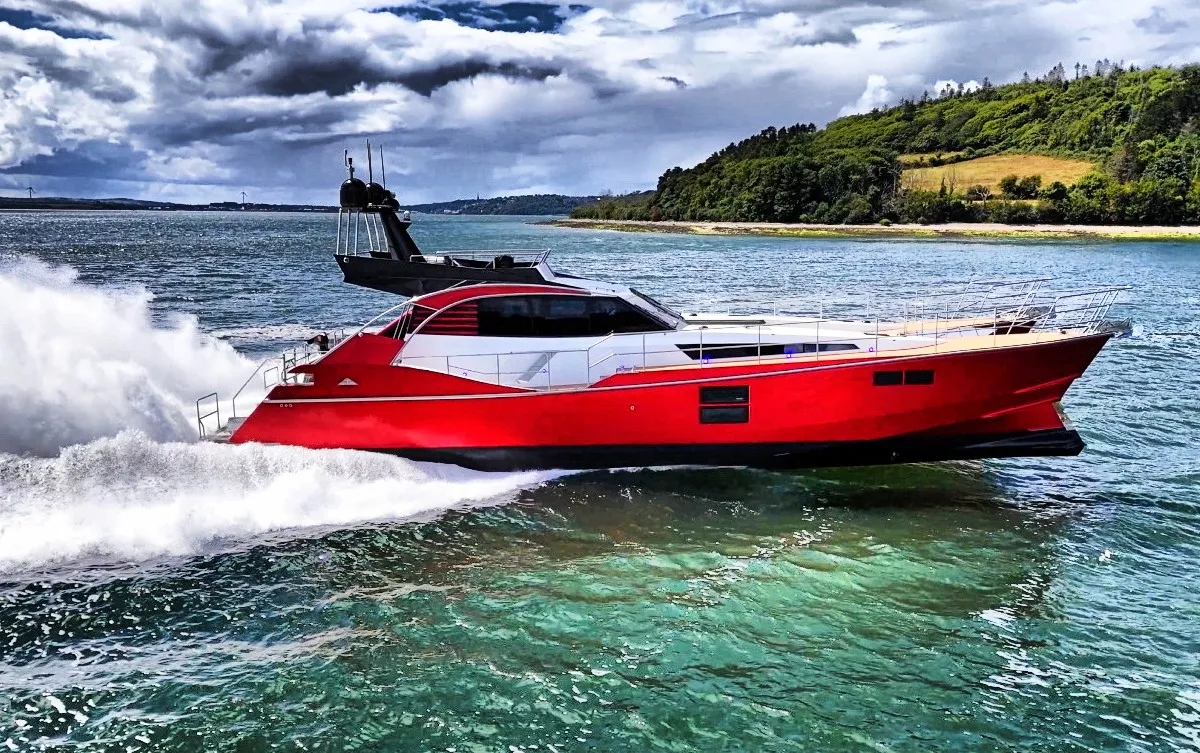
“We knew from scale-model tests that she should be able to tackle waves of more than 65 feet high,” Kowalski tells Robb Report. “But you never know until you’re out there. In the height of the storm, she just shrugged off the waves and weather and performed flawlessly.”
Evolved from Safehaven’s 75-foot XVS20 monohull launched in 2018, Kowalski used his expertise in building commercial, work-boat power catamarans to design the twin-hulled T-2000 Voyager to offer speed with stability.
“The stability in beam seas is what’s key here,” he says. “While we were out recently in a Force 8 with 40-plus knot winds and 12-foot seas, we were able to stop and leave the boat to drift while we retrieved a drone. It just took the waves on the beam with ease. In a monohull, it would have been rolling so badly you couldn’t have stood on the deck.”
Then there’s the sheer velocity that comes with twin, scalpel-thin hulls slicing through waves. With the T-2000’s pair of 1,550 hp MAN V12 diesels driving France Helices SD5 surface drives, the Safehaven can hit a top speed of 91 kph.
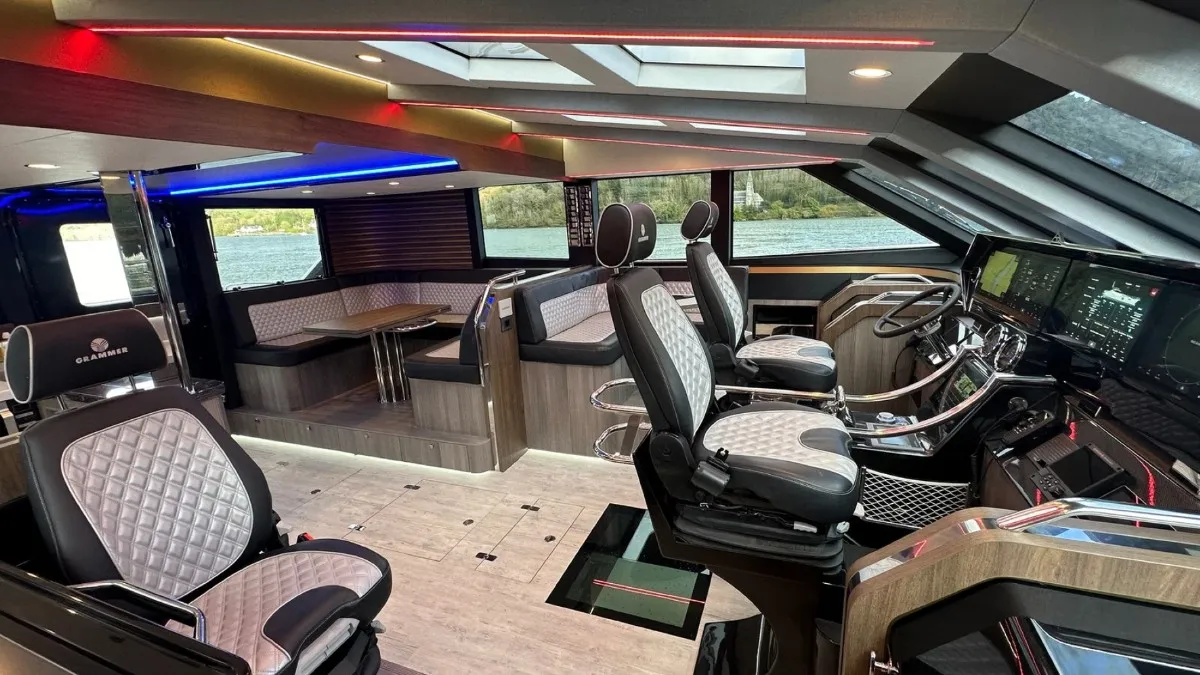
“It’s just the most amazing sight, standing on the stern, watching these huge roostertails behind,” Kowalski adds. “We’ve also incorporated retracting swim platforms so you can see the props spinning on the surface, plus valved exhausts that switch between silenced and straight-through. The noise from those V12s is sensational.”
While Safehaven has been building its Wildcat range of 40-, 53-, and 60-foot power cats for everything from oil-rig support, crew transfer, and even as a military cruiser for Britain’s Royal Navy, they were always pure, no-frills work boats. With this new T-2000, Kowalski is looking to appeal to private buyers searching for something a little different.
His hull No. 1 demonstrator boat has all-diamond-quilted marine leather, well-finished cabinetry, colored LED lighting, and below-deck accommodations for six in three cabins. Hull No. 2—already sold and due for completion in the next 18 months—will up the luxury factor.
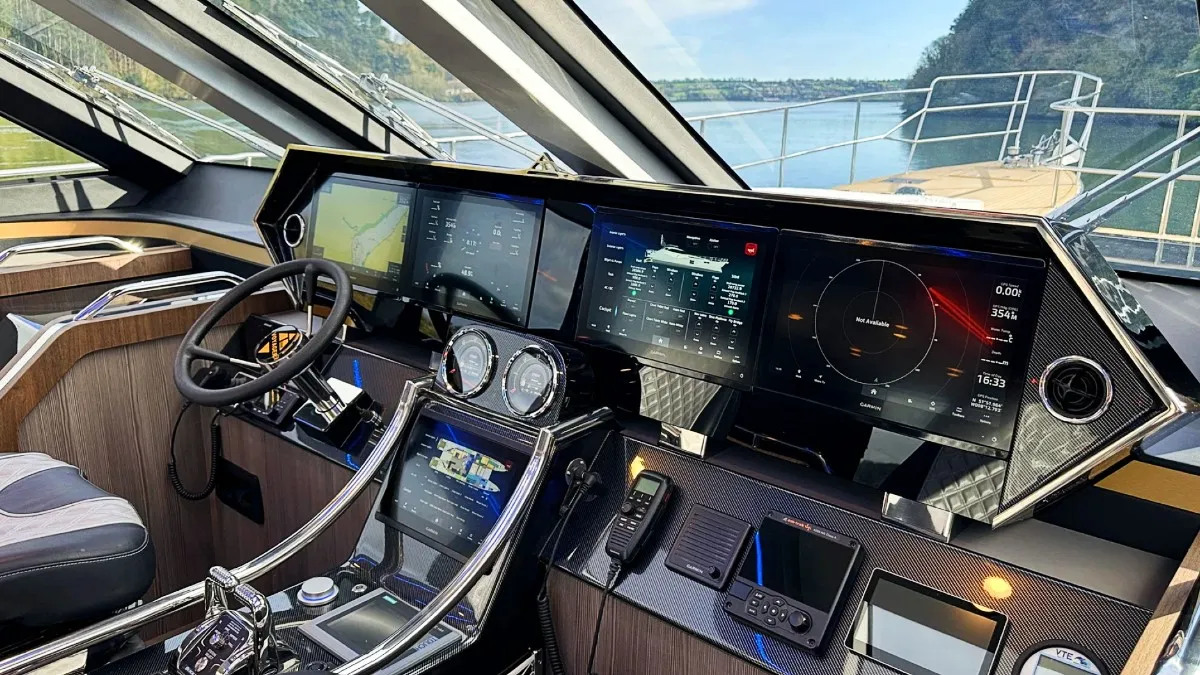
“It’s going to a client in the Middle East who plans to use it for just himself and his wife,” says Kowalski. The client has specified a full-width owner’s suite with a central, king-size bed and oversized his-and-hers bathrooms and closets in each hull. “He also wants to go fast—very fast,” Kowalski continues. “So we’ll install twin 2,000 hp MAN V12s, again with surface drives, and a central hydrofoil to reduce drag. The plan is for it to hit a top speed in excess of 100 kph.”
The new T-2000 is also designed to go the distance. With the 10,977 kilogram tanks, it has a range of more than 1,000 nautical miles at 55.2 kph, and 1,700 nautical miles at 28 kph. Throttle back to 19 kph and range increases to 3,000-plus nautical miles.
Much of this is down to the yacht’s symmetrical, semi-wave-piercing hulls, made of a carbon-fibre-composite construction, with inverted lower bow sections and a double-chine arrangement that projects spray clear of the boat. The hydrofoil in mid position also means that, at speed in calmish seas, the T-2000 rides with half its hull length out of the water.
To eliminate waves slamming into the bridge deck windshield, Kowalski moved the pilothouse farther back. It also makes for a sleeker profile, giving the T-2000 the look of a single-hull sportsyacht.
As for creature comforts, the main, open-plan salon features an L-shaped Corian-topped galley, with a U-shaped dinette opposite. To enjoy the action, there are bucket-style, shock-absorbing seats for the captain and copilot, a wraparound sofa on the port side, and a single bucket seat to starboard.
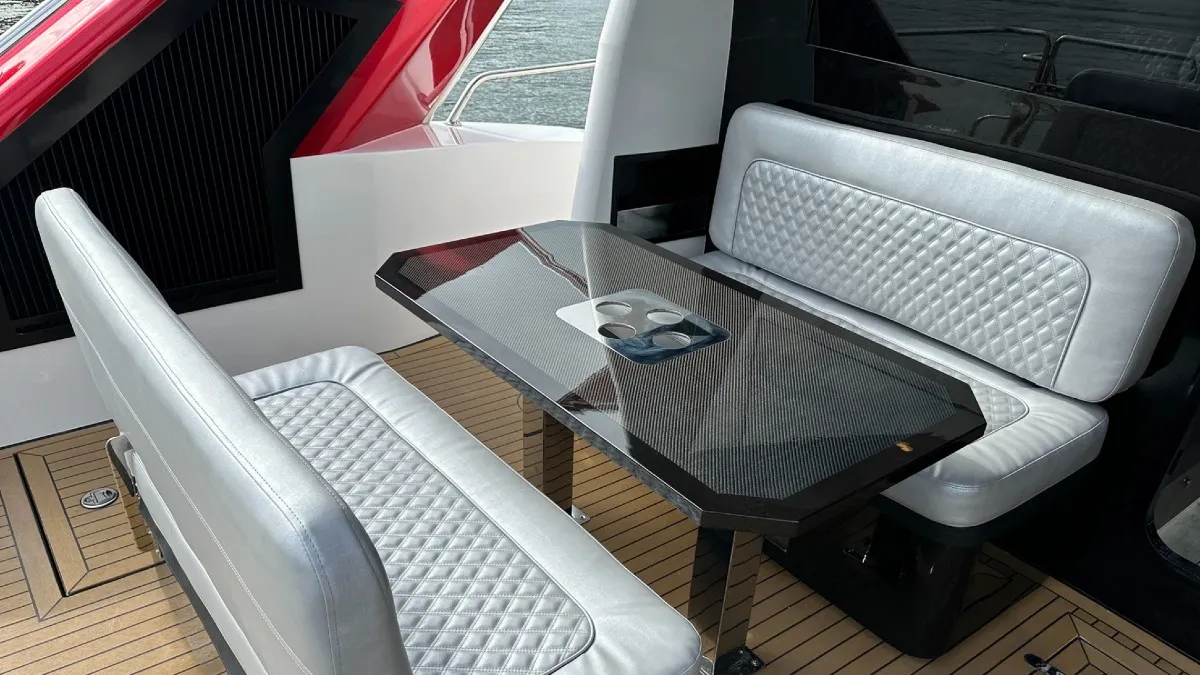
The entire helm area gets flooded with light courtesy of the four-panel, angled windshield and quartet of fixed skylights above. To see the boat’s hydrofoil in action, the bridge has a glass panel in the floor that’s also designed for viewing marine life below at night. Most of the windows have half-inch-thick toughened panels to shrug off cascading water.
In finer weather than typically found on coastal Ireland, the T-2000 has a small flybridge with a helm station and sun-lounge area up top, plus a covered stern cockpit with sofas and table for alfresco dining.
This storm-tested, metallic-red demonstrator is available for around $5 million.
You may also like.
Six Senses Are Suddenly Everywhere. Inside the Luxury Resort’s Growing Global Empire
With 26 properties now open, another 43 to come, and the U.S. square in its sights, the rapidly growing wellness-focused resort and hotel brand is now asking the hard questions
If someone hit you in the head (hard) just before the pandemic, and you’re only waking up now, in the middle of 2024, you’ll have noticed some changes. For instance, the global proliferation of Six Senses hotels and resorts.
Once a relatively quiet group of wellness-focused Asian resorts for in-the-know Europeans, Six Senses is now in the midst of a breakneck opening spree with the U.S. square in its sights. Since 2019—when hotel giant IHG dropped $440 million in cash to acquire the operator’s then 16 hotels and resorts from private equity group Pegasus Capital Advisors—it’s grown to 26 urban hotels and destination resorts in 21 countries across four continents. (Its Vana resort in India is one of Robb Report‘s 50 best luxury hotels in the world).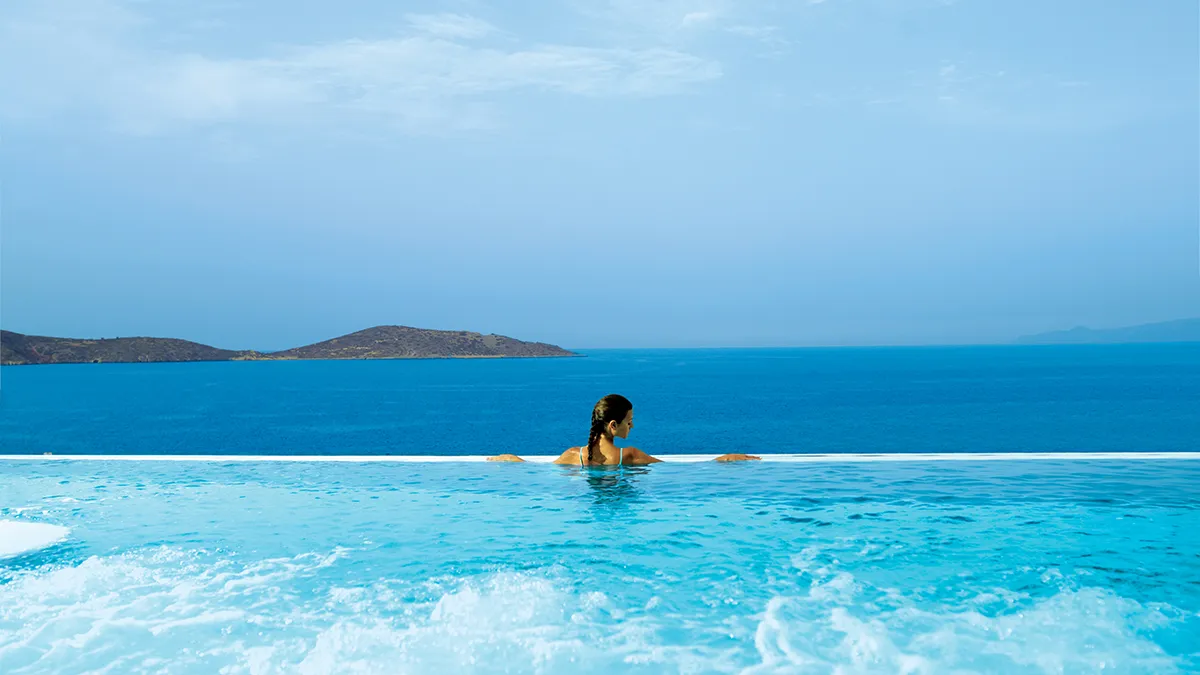
Blink again and that number may have doubled. By 2026, Six Senses, now the flagship brand of IHG’s luxury and lifestyle portfolio, hopes to have a shingle hanging in London, Bangkok, Dubai, Lisbon, Napa, and Tel Aviv. There are currently 43 Six Senses in the pipeline, which will extend Six Senses footprint from the Carolinas to Victoria Falls. Many of those new properties will come packed with branded residences.
So is Six Senses trying to conquer the world via ayurvedic medicine, longevity spa treatments, and mindfulness exercises?
“It’s been a hell of a ride,” admits CEO Neil Jacobs. “But the answer is no, and we have a real point of view on that.”
More on that point of view momentarily, but it’s worth pausing to note that despite his protestations, Jacobs comes to Six Senses with 14 years of experience with a hotel group that is arguable much more overtly interested in turning planet Earth into one massive 5-star hotel lobby: namely, the Four Seasons. As senior vice president of operations for the Four Seasons’s Asia Pacific region, he witnessed the company expand from roughly two dozen hotels into the 130-ish-address, Bill Gates– and Prince Al-Waleed bin Talal–owned leviathan of luxury it is today. The Four Seasons’s stated goal is 200 hotels. But Jacobs tells Robb Report it’s neither his or IHG’s intention to turn Six Senses into the Michael Kors of opulent wellness resorts.
“We think less is more,” he says of that aforementioned point of view. “Our competitors are all about growth. With Six Senses the conversation is very much the opposite of that. You’ve got to be really careful about what you do and where you go. I mean, we started with eight resorts in 2012. Then there were 11, and we got rid of two or three. Today, there are 26. So we’ve only opened 18 in nearly 12 years, really.”
Still, the Bangkok-based company is hurtling toward 60-plus properties, a number Jacobs says he is “comfortable” with. What happens beyond that is stickier.

“We have four projects in Italy. We could do another five, but why?” says Jacobs. “Instead, let’s move to another country and spread, rather than just inundate the brand in one country, even though there’s places to do it. It’s a continual argument internally. We have some great places coming to Italy, but we don’t have Venice. So then my team says, ‘If we have a Venice deal, are you going to say, ‘Don’t do it?’ Good question. But the answer is, ‘maybe.’”
Whether it’s Six Senses, the Four Seasons, or Auberge (another brand that has seen a similarly rapid expansion), the answer to the question “When does quantity extinguish the spark of quality?” is worth at least a billion. But it’s also a problem that highlights the welcome fact that, despite the current slump, “luxury” is winning; it may have already won.
From fashion to travel, a growing share of businesses have repositioned themselves to serve the high-end consumer, as growing global wealth supports superior margins realized through the relative simplicity of a luxury rebrand. The affordable family resort of yesterday becomes the aspirational seaside playpen of today. As long as demand for luxury everything is here, deep-pocketed hotel groups will grow to meet it.
At the same time, the success of “luxury” creates a clear existential dilemma: If luxury becomes the standard setting, it is by definition no longer an indulgence, no longer a luxury. And as luxury becomes more gray and undifferentiated, the vague, eye-of-the-beholder quality that was once its strength, is now its liability.
It’s a problem that Jacobs feels that Six Senses was uniquely designed to address.

“That sixth sense in our name, we see it as intuition,” he says. “It’s interesting because one of our initiatives for this year in wellness is spiritual wellness. In the past, we’ve done a lot of yoga, we’ve done a lot of meditation, but we haven’t done a lot of overtly spiritual programs. We think the time is right.”
Those programs serving up, non-religious, lightly-woo spirituality on a silver platter roll out later this year and offer a key differentiator for the brand’s fastest growing customer base: Americans.
“Back in 2012, it was predominately a European customer, I’d say 85 percent,” says Jacobs. “There was no business coming from the U.S. Today, the U.S. is our number market, even though we don’t have anything open in the U.S.”
It’s not for lack of trying. Six Senses planned to open in Manhattan along the High Line in a doomed Bjarke Ingles–designed tower that was crushed by a Gambino crime family construction bribery scandal and the subsequent bankruptcy of its developer. Six Senses has since found a new site on 23rd St. between Seventh and Eighth Aves. in Chelsea, but is at least three years out.
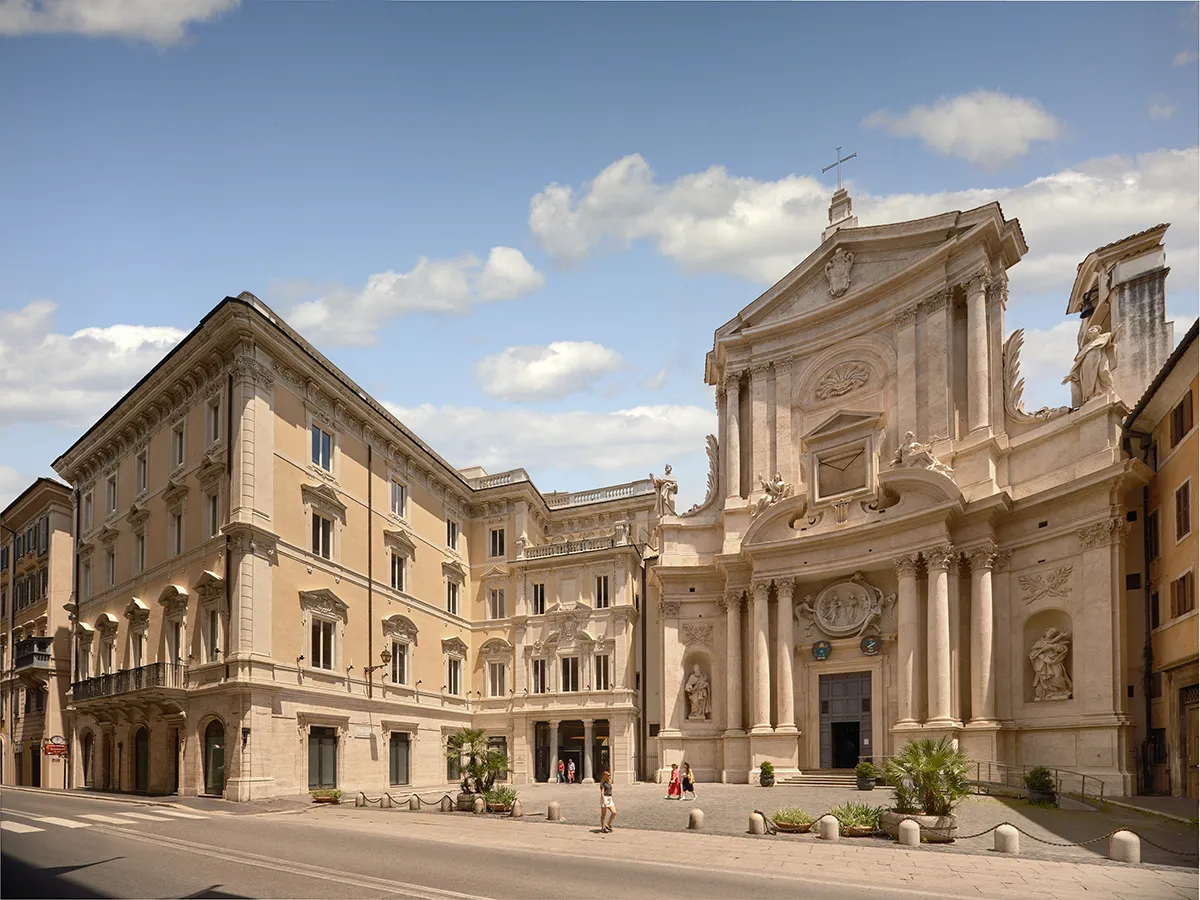
It’s having a better, if not altogether easier, time with the 236-acre farm in Hudson Valley in Upstate New York. The site of a failed “secret hotel” project, Six Senses snatched up the land for $20.2 million in 2022, making it some of the only real estate the brand owns (as with many brands, outside investors typically carry the deeds). Although it would be the first five-star flag in the region, the project has faced community opposition that could scuttle yet another attempt to create a footprint in the U.S.
“I don’t think it’s going to work,” Del LaMagna, whose property shares a border with the site, told the Hudson Valley Pilot. “[IHG] decided they wanted to be here, they started hiring good local people to figure it out, but this whole idea of exclusive resorts for rich people just doesn’t work up here.”
That’s a matter of opinion, but Six Senses plans for the U.S. extend far beyond the town of Clinton. Besides urban hotels in New York, L.A., and Miami, it will open a series of resorts, starting with a 500-acre estate on the edge of Napa and a multi-island project off the coast of South Carolina spanning Hilton Head, Daufuskie, and Bay Point. The gargantuan scale of those properties will eventually facilitate the festivals and retreats that the brand has been recently investing in.
“It’s a lot of yoga, a lot of spirituality, a lot of fun, a dance, a lot of movement,” he says. “Those kinds of festivals resonate with people.”
So if you’re just waking up, welcome to a world where Six Senses is everywhere all at once. But Jacobs hopes that by selecting “extraordinary properties” and by “demonstrating our values in a highly meaningful way” that the resorts will fit into the ecosystem like redwoods in a pine forest. Call it a sixth sense.
You may also like.
Rolls-Royce Debuted the New Phantom Scintilla at Monterey Car Week. Here’s Everything We Know.
Limited to 10 examples, each car has an interior defined by “painting with thread,” and a rumored price of around $2.6 million.
Visitors to the fabled Louvre Museum in the heart of Paris might remember an exquisite marble sculpture standing proud at the top of the main Daru staircase. Named the Winged Victory of Samothrace, this eight-foot-tall headless goddess—with gossamer wings—dates to 190 B.C.
What has it got to do with Rolls-Royce’s new Phantom Scintilla Private Collection limousine, unveiled during this year’s Monterey Car Week? A lot, in fact. Rewind to 1910 and Rolls-Royce’s managing director at the time, Claude Johnson, who reportedly commissioned well-known sculptor Charles Sykes to create a hood ornament to define the new Rolls-Royce brand. Apparently, Johnson had seen the statue during a visit to the Louvre and fell in love with it.
While a change in direction saw Sykes create the Spirit of Ecstasy, inspired by Johnson’s former secretary, English actress and model Eleanor Thornton, the Louvre statue was always considered by Goodwood to be the original inspiration for its now iconic emblem.
So, when Rolls-Royce designers looked for a muse for a 10-car, Phantom-based Private Collection series to be called Scintilla—derived from the Latin word for “spark”—the marque went back to the Winged Victory of Samothrace statue and its Mediterranean roots.
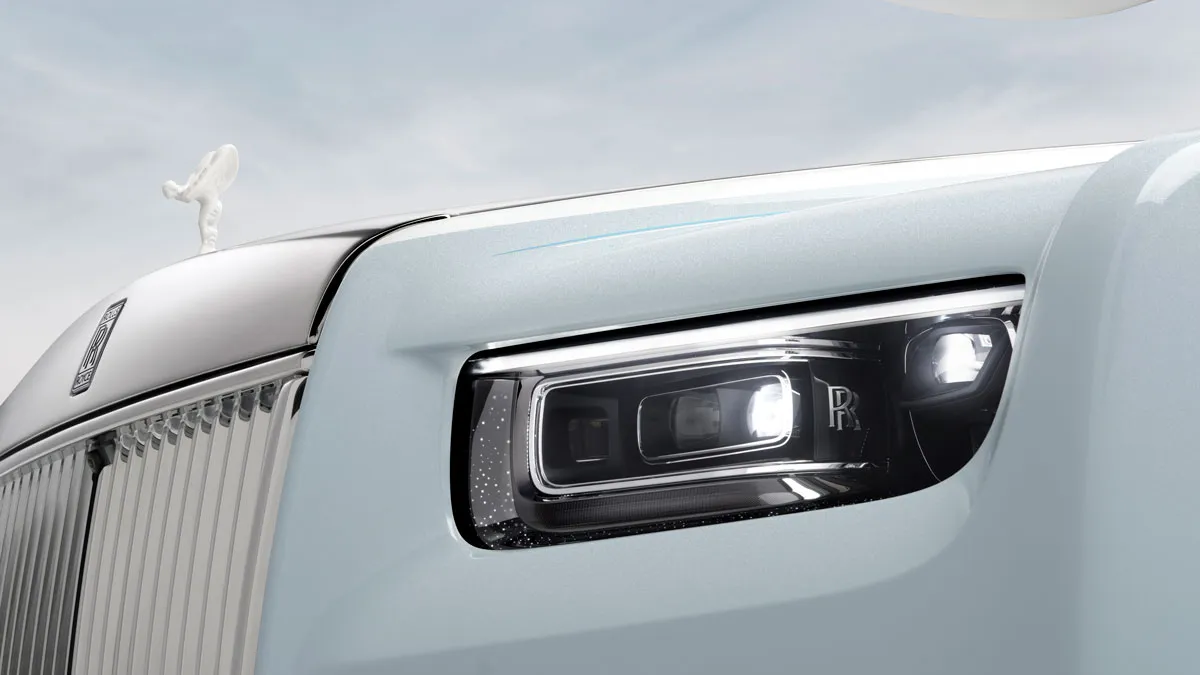
You see that influence in the car’s Spirit of Ecstasy figurine which, for the first time, features a translucent white, marble-like ceramic coating. It also carries over in the car’s two-tone paintwork—Andalusian White for the upper body, and powdery Thracian Blue, inspired by the color of the Med, for the lower section. A subtle metallic flake in the paintwork is said to mimic the sparkle of sunlight off the water.
Yet as with most bespoke and special-edition Phantoms, it’s the interior where Rolls-Royce craftsmanship is truly exhibited. In this case, the theme is exquisite embroidery or, as the automaker calls it, “painting with thread.”

For Scintilla, the embroidery work involves over 850,000 individual stitches. And at night, illuminated perforations in the material give the doors a wave-like glow. In Phantom tradition, there’s a Starlight Headliner in the roof, but here, more than 1,500 fiber-optic illuminations twinkle in sequence to mimic silk billowing in a breeze.
The centerpiece of the interior is the Phantom’s dashboard gallery ahead of the front-seat passenger. Named “Celestial Pulse,” it comprises seven metal ribbons, each individually milled from solid aluminum and given the same finely grained ceramic finish as the Scintilla’s Spirit of Ecstasy.
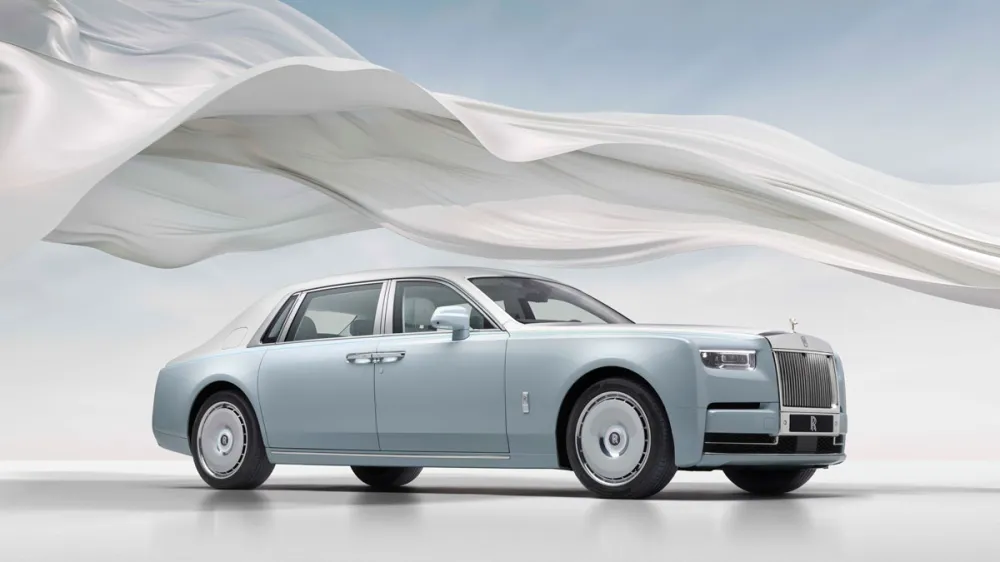
Rolls-Royce will build only 10 examples of the Phantom Scintilla, which had its public debut at the Quail, a Motorsports Gathering on August 16. Of that already small number, three will come to North America and, like the other seven, have already been sold. While there’s no official word on pricing, the figure $3.8 million has been reported.

“With every collection, we aim to tell the story of Rolls-Royce Motor Cars and provoke our clients’ imagination, letting them know our Bespoke designers’ artistry is greater than they can envision,” stated Martin Fritsches, president of Rolls-Royce Motor Cars for the Americas, when asked for a comment by Robb Report. “We can’t think of a better way to tell this story than through the history of our idol, the Spirit of Ecstasy.”
You may also like.
Astonishing Nature, At Its Most Magnificent
Scenic Eclipse hones 6-star ultra-luxury around Antarctica’s raw nature.
Picture this. You’re sitting at the Sky Bar on the Scenic Eclipse II. It’s freezing outside, but you’re warm and dry, sipping a delicious glass of pinot noir as you watch a colony of penguins play on the ice sheet. Is this a dream? Or just another incredible moment from the 6-star ultra-luxury discovery yacht Scenic Eclipse?
It may sound too good to be true, but Scenic has over-engineered their two major Polar ocean-going vessels (Scenic Eclipse & Scenic Eclipse II) to offer up mind-blowing opportunities to connect to untouched nature. While the White Continent continues to hold pride of place on most people’s bucket list, few will ever experience it in such refined style.
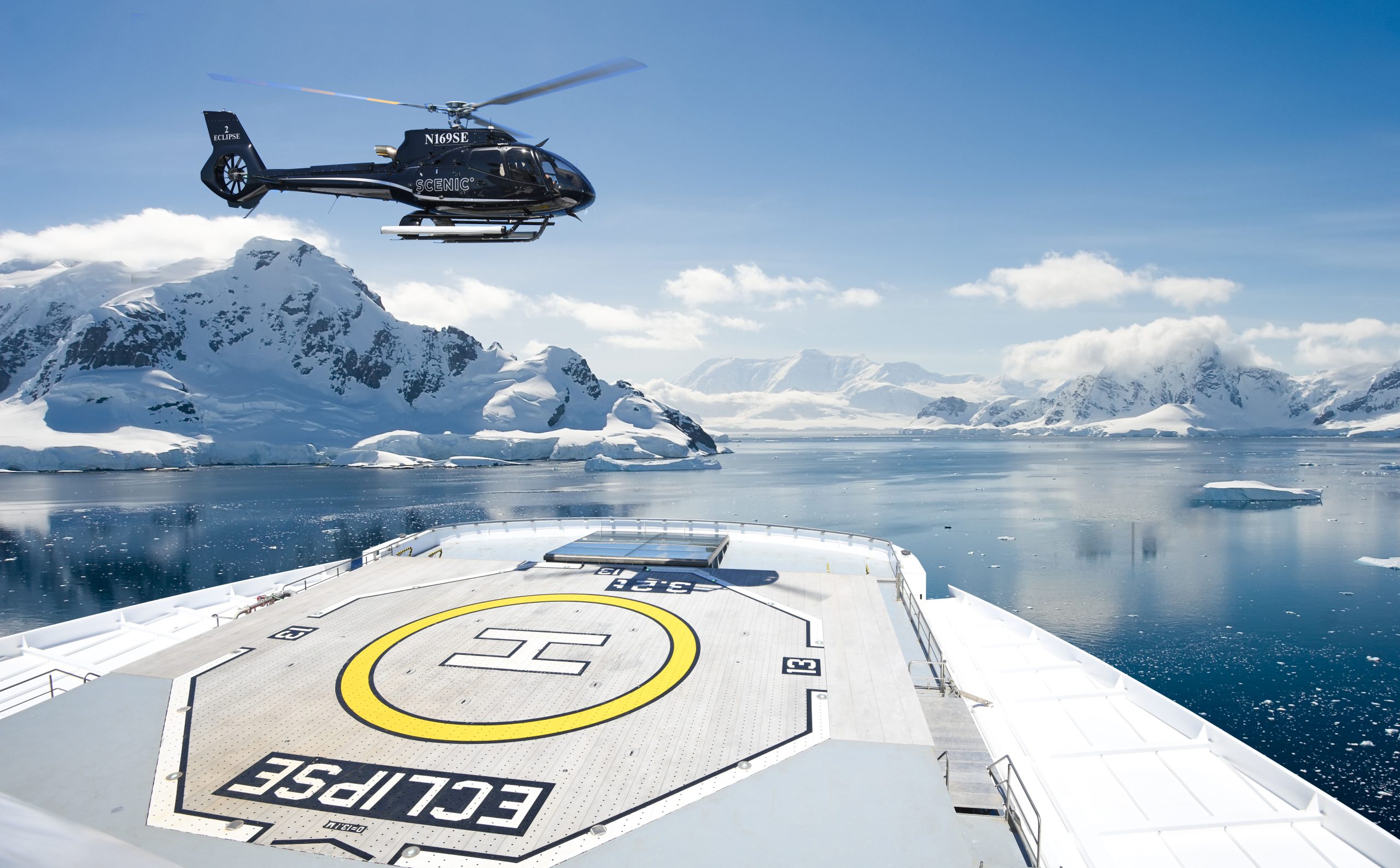
With just 200 guests on board in Antarctica for more landing opportunities, Scenic has decked out their vessels out with 6-star hotel facilities, and equipped them with luxury tech toys to satisfy even the most restless traveller.
They offer an impressive close to one-to-one staff-to-guest ratio, up to 10 dining experiences , as well as two state-of-the-art on board helicopters^, Zodiacs and a custom-built submersible^ for further discovery in the destination. Paddle boards and kayaks are deployed regularly (conditions permitting), and guests are provided with polar boots for land-based snow treks.
This is not a floating hotel but a discovery yacht for the discerning traveller. Daily plans are shaped around the weather and sea conditions. A typical day can include a leisurely breakfast and visit to the 550sqm Senses Spa#, morning and afternoon discovery excursions, lunch in your venue of choice or in your suite, and a delicious on board culinary experience for dinner before heading to your spacious suite with verandah to unwind.
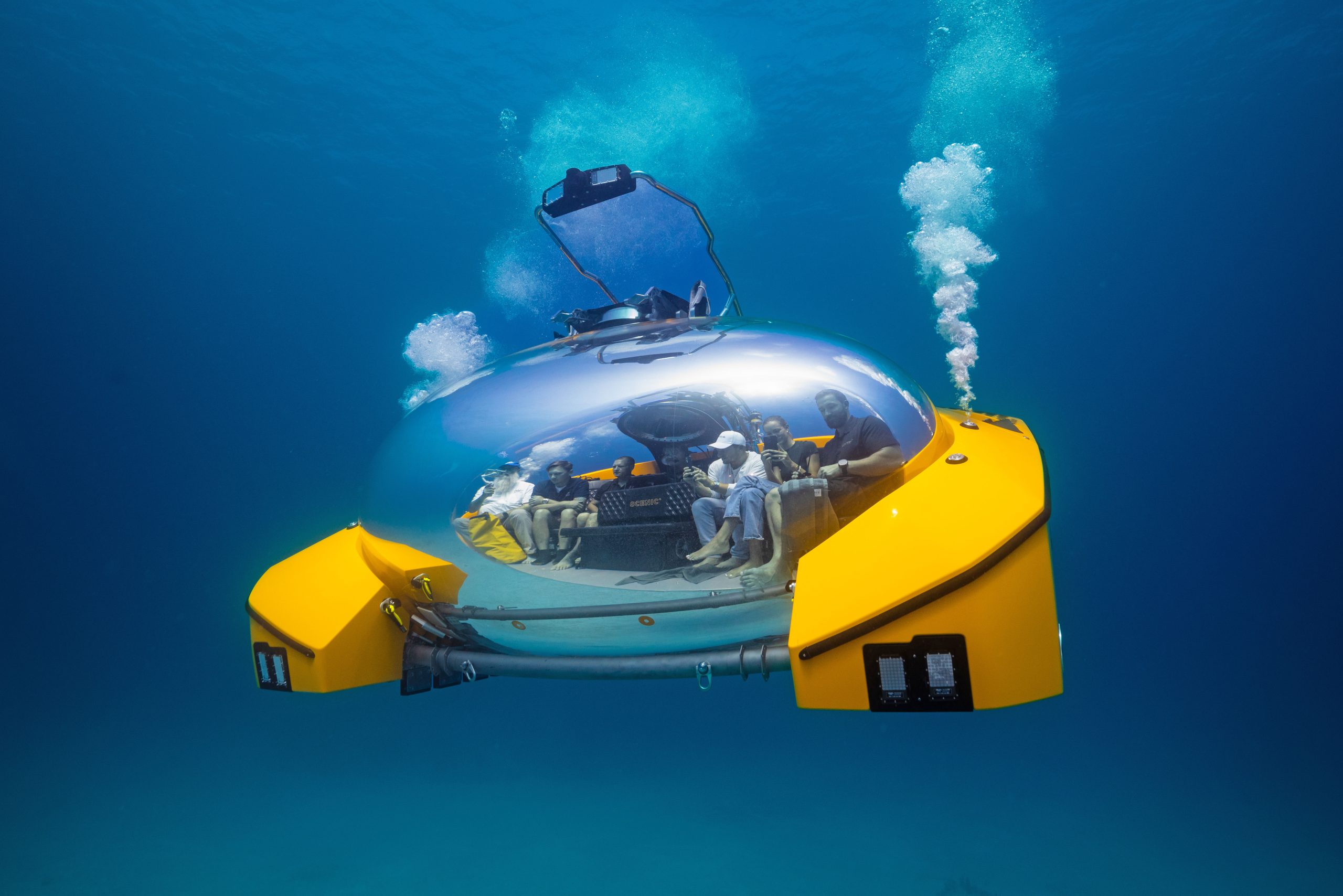
When not out with the expert polar Discovery Team relax in the Observation Lounge or indulge in a sauna and massage in the 550sqm Senses Spa# wellness retreat. For your daily entertainment there are whales, penguins, orcas and seals to observe and document.
The two major trips that depart for East Antarctica from our part of the world in the next several months are Mawson’s Antarctica: Along the East Coast, which leaves from Queenstown, New Zealand in December and Antarctica’s Ross Sea: Majestic Ice & Wildlife which leaves from Dunedin in January 2025.
The first itinerary celebrates one of Australia’s national heroes, Sir Douglas Mawson, who occupies a place on the $100 note. This itinerary allows guests to follow in the footsteps of this intrepid explorer, retracing his travels across the continent in the name of scientific research. The trip takes in remote bays and ravishing coves, placing guest in breathtaking landscapes where wildlife reigns supreme.
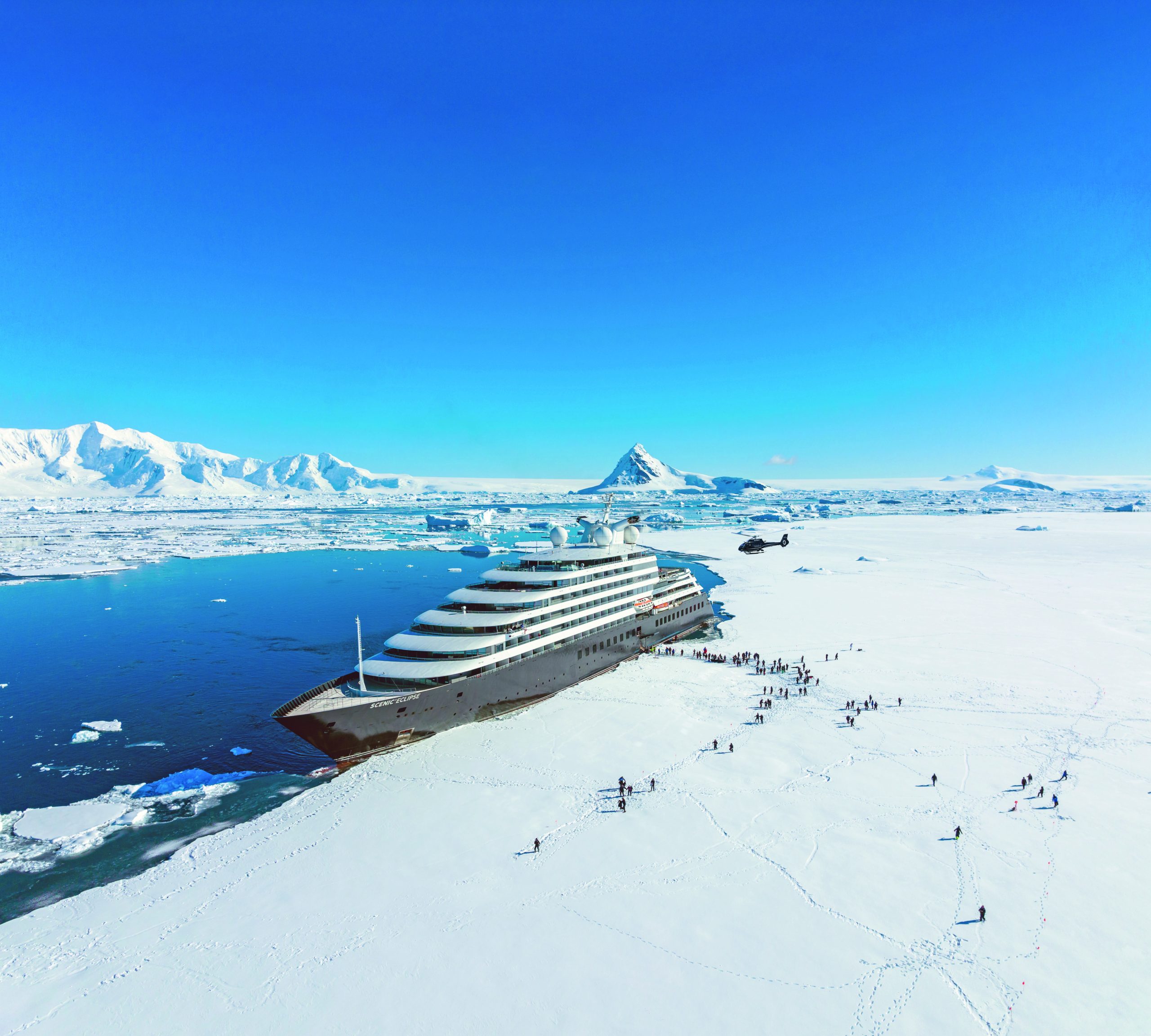
Led by the expert polar Discovery Team, guests can also opt to dive below the depths of the polar waters in the custom-designed submersible Scenic Neptune II, or take to the skies in the two on board state-of-the-art helicopters (for an additional cost). Guest on this voyage will enjoy a heli-shuttle directly from the discovery yacht to view the remains of Mawson’s Hut. The Mawson 25-day all-inclusive itinerary departs from near Queenstown to Hobart on 15 December 2024 and 13 December 2025 and is priced from $39,270pp* with savings of $13,000pp* and a 50% off the Deluxe Verandah Suite upgrade.
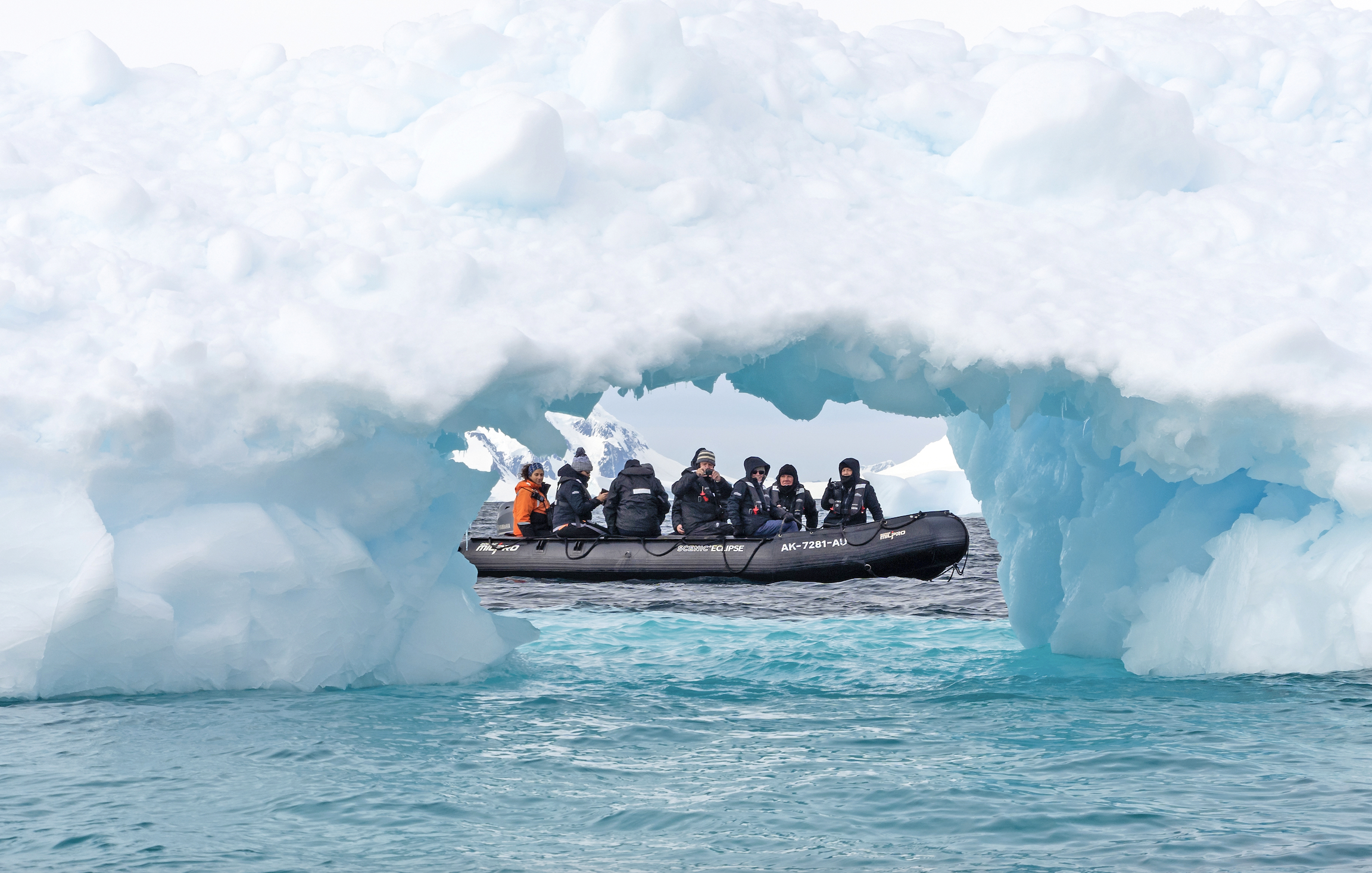
The Antarctica’s Ross Sea: Majestic Ice & Wildlife is voyage of a similar length, 24 days, but here the journey has a very end-of-the-earth feel to it. Striking ice landscapes offer vistas of gem-like glaciers, views to towering icebergs and jagged mountain ranges that form the backdrop to epic wildlife displays.
For nature lovers, the Ross Sea represents a holy grail, one that’s absolutely teeming with whales, orcas, penguins, seals and migratory seabirds. Day trips and land excursions here are all crafted in response to weather, by the expert polar Discovery Team and Captain who know the terrain.
These are side trips and excursions that are well designed to take advantage of the close access to truly life changing experiences and each one is a show-stopper.
Once again guests can opt to book the helicopter^ excursion for an extra cost to fly off and land in the McMurdo Dry Valleys, a place like no where else on earth where the snow is void or take a dive in the submersible^ to see what lies beneath.
This all-inclusive ultra-luxury, 24-day itinerary, departs from Dunedin, New Zealand on 31 January 2025 and 29 January 2026 and the voyage starts from $38,970pp* with savings of $13,000pp* and a 50% off the Deluxe Verandah Suite upgrade .
To learn more, visit: scenic.com.au
*Terms and Conditions apply.
^Flights on board our two helicopters and submersible experiences are at additional cost, subject to regulatory approval, availability, weight restrictions, medical approval and weather, ice and tidal conditions.
#Spa treatments at additional cost.
You may also like.
The Small Dress Watch Is Back
Drawer the Daytona—a small, slim dress watch is the discerning wristwear of the moment.
For the first time in decades, dress watches—from simple, three-hand Patek Philippes to flamboyant Cartiers—are running circles around sports watches with regard to both desirability and style.
“In terms of taste, things have changed,” says David Hurley, deputy CEO of the Watches of Switzerland group, a retailer with 30 multi-brand and 25 mono-brand partnership stores across the U.S. While until recently demand “was all about the steel sport timepiece, ” he says, “now we’re seeing dress watches and brands such as Jaeger-LeCoultre”—long esteemed for its formal models—“performing well in our stores.”
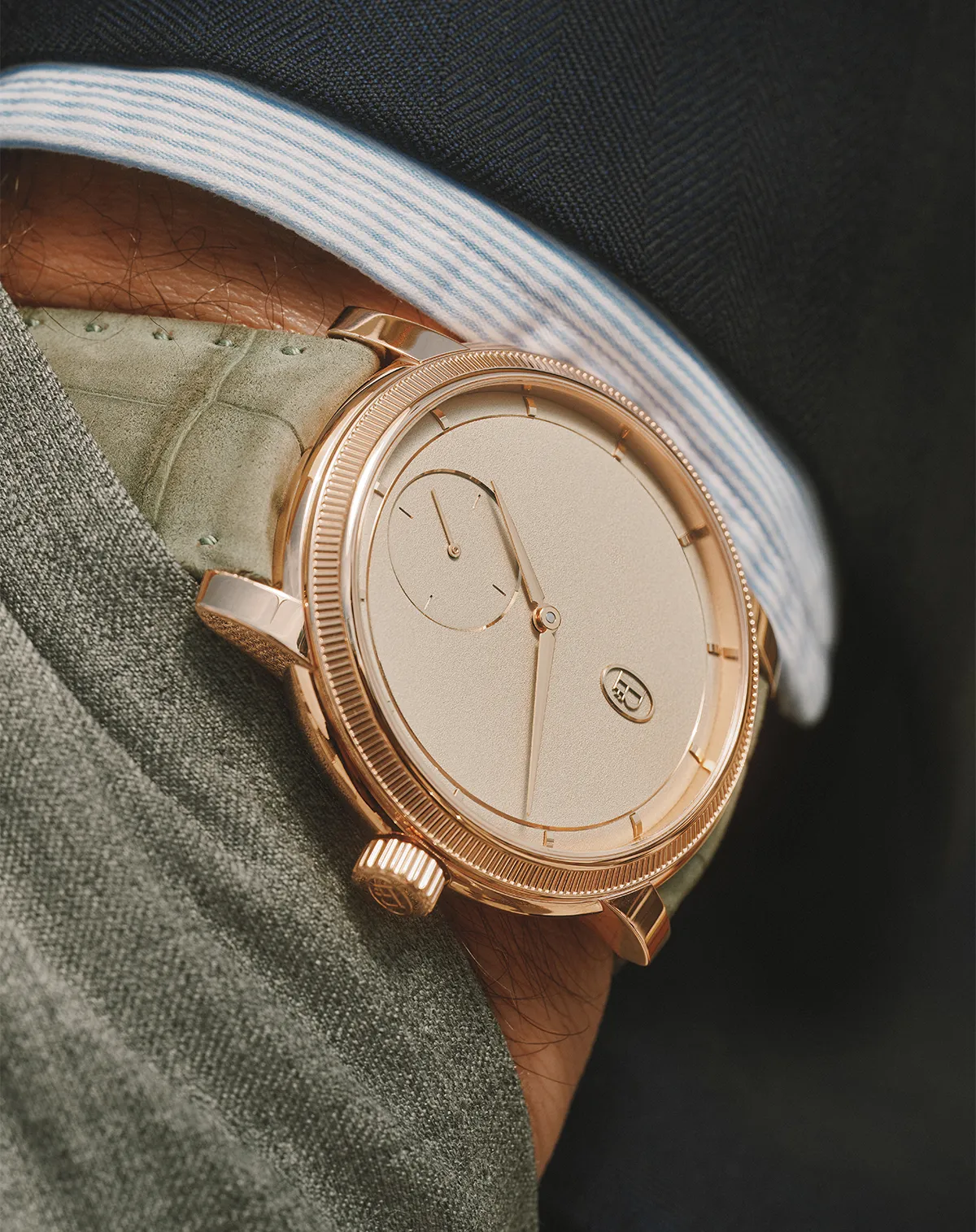
The genesis of the shift dates back to the early days of the pandemic, when secondary prices on blue-chip sports watches such as the Rolex Daytona, Patek Philippe Nautilus, and Audemars Piguet Royal Oak began clocking staggering monthly increases; by early 2022, some pieces were fetching five times retail value. Then, in May of that year, the crypto collapse triggered both a decline in secondary-market values and an exodus of speculators who were only in the game to make a quick buck. Genuine enthusiasts who had been lured to sports models by the prospect of a rapidly appreciating asset were also free to return their attention to timepieces that better reflected their tastes.
“People who got priced out of these sports models suddenly realised they could go into a Patek Calatrava at retail price,” recalls Eddie Goziker, president of the pre-owned dealer Wrist Aficionado. “The market pushed them in that direction. And once they got there, they saw the value in it and stayed.”
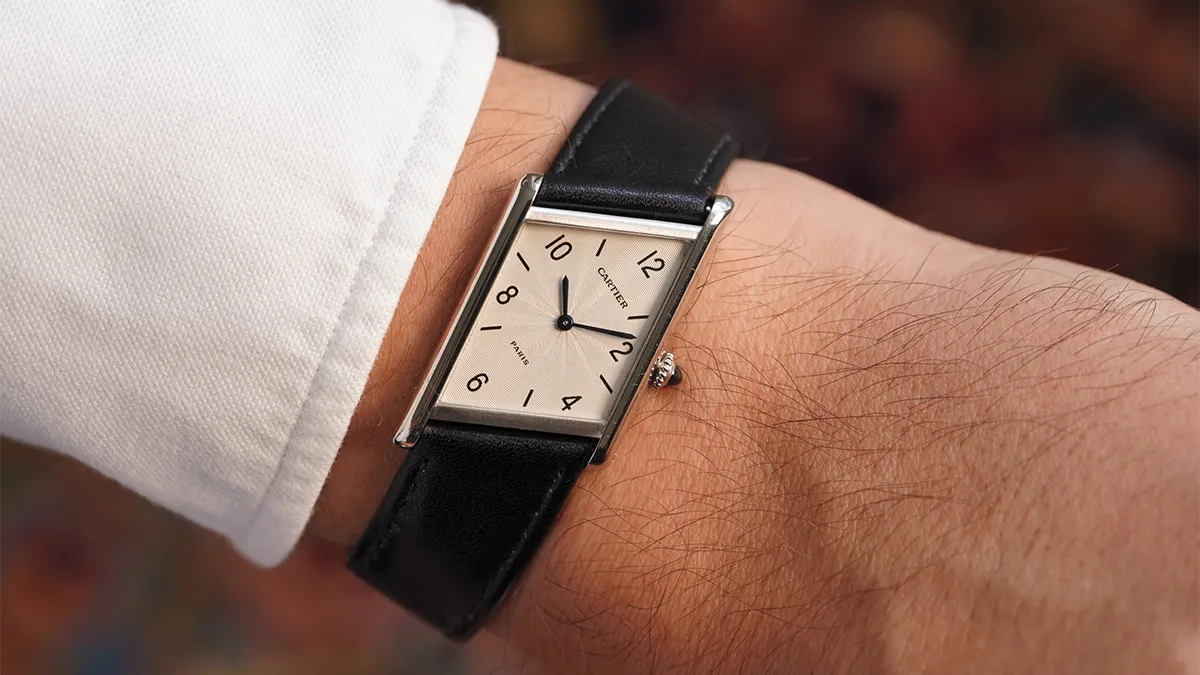
With the vogue for smaller cases already in full effect, the clamor for slim, classic styles presented on a leather strap is now at a crescendo, according to vintage dealer Mike Nouveau. “The Patek 96, the first Calatrava ever, is 30.5 mm, and they made that watch for 40 years,” he says. “I’m buying and selling them like crazy, both for my personal collection and for clients.”
“There’s a ton of interest in Calatravas, vintage Vacheron Constantin, obviously Cartier,” says Eric Wind, owner of Wind Vintage in Palm Beach, Florida. “The steel sport watches used to be an ‘if you know, you know’ watch,” he says, explaining the aesthetic about-face. “The Nautilus 10 years ago used to be unknown. Now everybody on the planet knows what it is.”
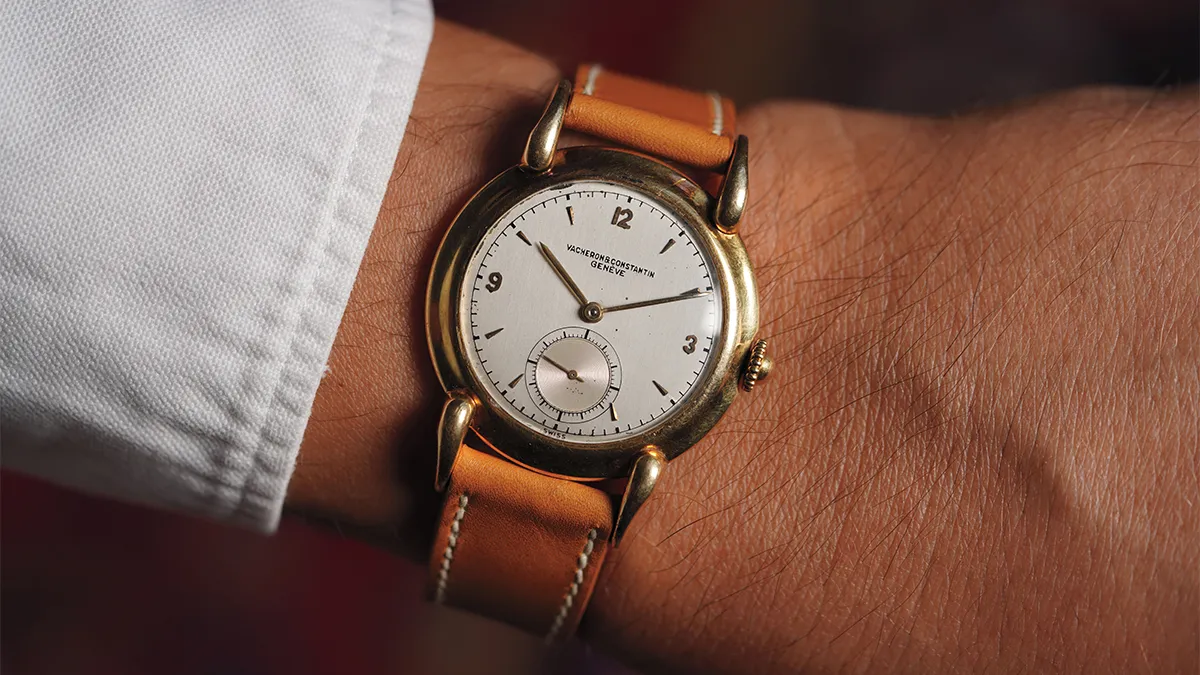
And that, he notes, includes thieves, further helping the trend toward smaller, simpler, more discreet timepieces. “I know two people who had Patek Aquanauts stolen off their wrists, and another client had a gold Rolex Day-Date stolen in Brussels,” Wind says. “People don’t have the same connotation if you’re wearing an old dress watch—it’s more of a quiet luxury.”
But in the enthusiast world, of course, the quietest luxury can also be the loudest flex, and for dress watches, that includes the strap. Wind notes that bands by Paris-based leather-goods maker Jean Rousseau are afforded particularly high status. “A baller move is getting a Jean Rosseau with a single punch, just for their wrist,” he adds.
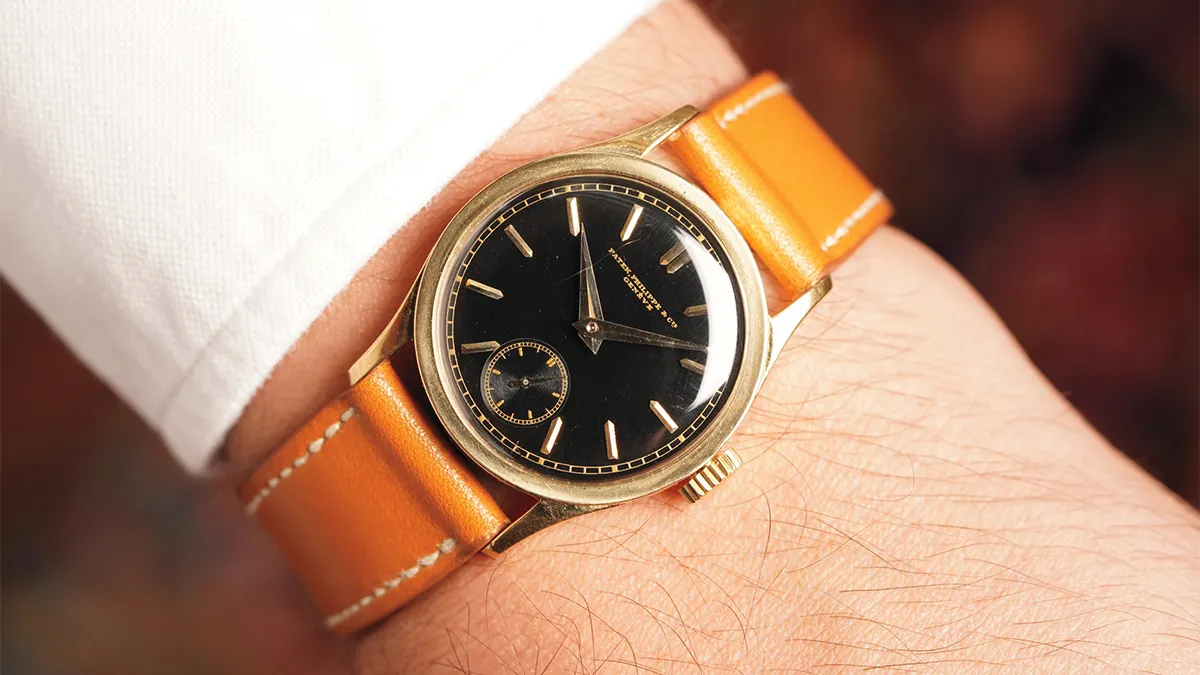
And the tremendous breadth of dresswatch designs, from simple three-hand models to ultra-complicated wonders, is a boon for collectors. If your tastes run to sober, sophisticated German watchmaking, a Saxonia by A. Lange & Söhne is just the ticket. A devoted minimalist? You can’t go wrong with the latest Toric collection from boutique maker Parmigiani Fleurier. Fans of more obscure brands would do well to consider the Patek-inspired (and typically sold-out) timepieces by Kikuchi Nakagawa, in Tokyo. Nouveau, for his part, recommends vintage Piaget and Breguet.
Even traditionally sporty brands are getting in on the action. At the end of May, Audemars Piguet introduced the [Re]Master02, a minimalist, asymmetrical homage to a 1960 model, from its extra-thin hour and minute movement to its matte-blue alligator strap, that’s on trend for the current dress-watch moment.
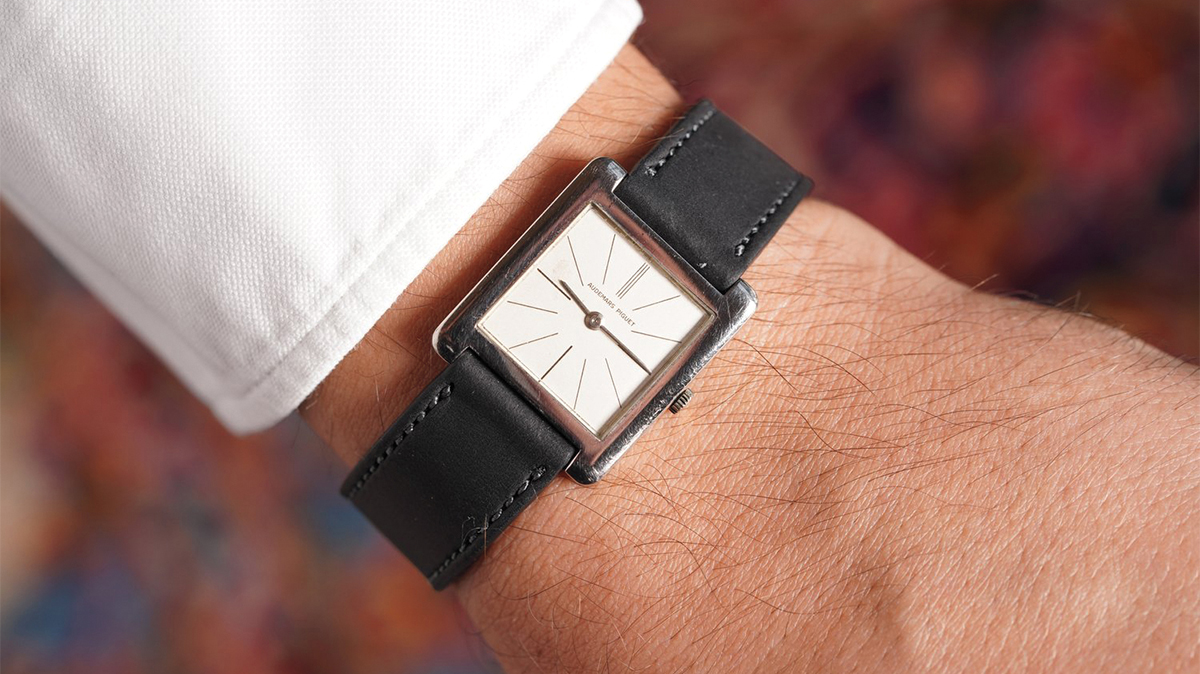
For yet more proof, consider Rolex’s increasing emphasis on its new 1908 Perpetual collection. Introduced in 2023 and expanded earlier this year with a 39 mm platinum model featuring an ice-blue guilloche dial and a brown alligator-leather strap, the 1908 is as sophisticated and gentlemanly as the brand’s iconic sports watches are rugged.







